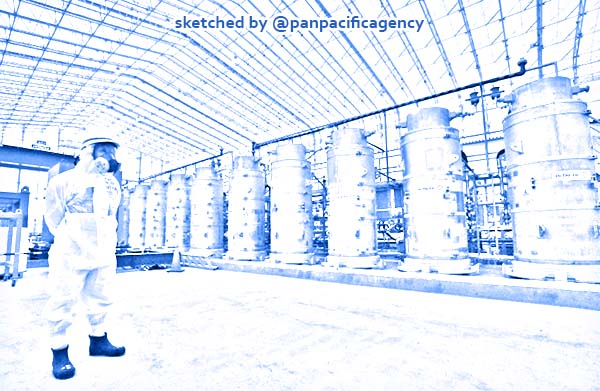Japan’s nuclear fuel imports almost zero in 2019 as industry stagnates

In this Nov. 12, 2014, file photo, a Tokyo Electric Power Co. (TEPCO) official wearing radioactive protective gear stands in front of Advanced Liquid Processing Systems during a press tour at the Fukushima Dai-ichi nuclear power plant in Okuma, Fukushima Prefecture, northeastern Japan. (AP Photo/Shizuo Kambayashi). Sketched by the Pan Pacific Agency.
TOKYO, Aug 12, 2020, Kyodo. Japan’s imports of fuel to power nuclear plants were close to zero last year, reflecting the stagnating nuclear industry following the Fukushima disaster in 2011, official trade data showed Tuesday, The Japan Times reported.
The effective halt to Japan’s imports of enriched and natural uranium or their assemblies is believed to be the first since the resource-poor country started securing the materials from overseas in the 1960s.
Most nuclear plants in Japan remain idle as stricter safety measures were implemented after a massive earthquake and ensuing tsunami crippled the Fukushima No. 1 nuclear complex. The operations of fuel manufacturing plants have also been suspended.
Japan’s imports of the fuel started around the time the country’s first commercial nuclear power station in the village of Tokai, Ibaraki Prefecture, achieved criticality in 1965.
The value of the three materials reached a record ¥280.4 billion ($2.64 billion) in 1984 as nuclear power plants increased, according to the government data.
In subsequent years, the value was around ¥100 billion to ¥150 billion before the level fell to ¥82.7 billion in 2012, one year after the Fukushima disaster.
In 2016, the value decreased further to ¥2.9 billion as more nuclear power plants were halted. Due to the resumptions of some nuclear plants, it recovered to nearly ¥50 billion in 2017 and 2018. But, it fell to ¥45 million in 2019, with small amounts likely imported for research purposes.
Comparable statistics for such materials are available from 1972.
Of the 54 nuclear reactors that were in operation before the Fukushima crisis, currently, only nine have come back online after clearing harsher safety measures.
In the wake of the accident, 21 reactors have been flagged for decommissioning in consideration of the hefty cost of refurbishment.
All four fuel manufacturing factories are offline as they are undergoing regulatory review under the new safety standards.
Kansai Electric Power Co., Shikoku Electric Power Co. and Kyushu Electric Power Co., which operate the nine plants currently back online, said they have enough fuel to run their reactors for the next several years.
Despite the slumping nuclear industry in Japan, the government has set a target for nuclear power generation to account for 20 to 22 percent of the country’s electricity supply by 2030, which requires resuming operations of 20 to 30 reactors.